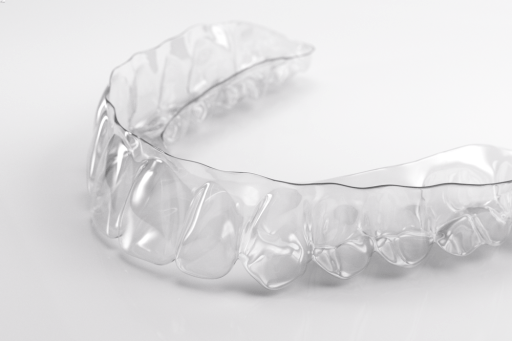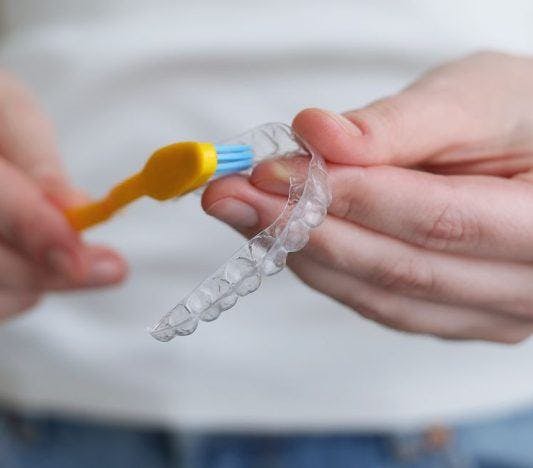If you’ve decided to undergo orthodontic treatment with clear aligners, it pays to know what proper cleaning looks like for your appliance. The good news is they’re much easier to wash vs their fixed counterparts since you can take them off. What’s not to love about that? It’s still best to consult your treating dentist for specific instructions on how to clean aligners when you get your first tray. But in the meantime, use this guide to understand the basics and get additional maintenance tips.
Expert-recommended cleaning methods for clear aligners

Since aligners stay in the mouth, they’re susceptible to the same bacteria as your tongue, teeth, and gums. Regular cleaning helps manage buildup that can cause plaque, bad breath, and other issues. It also keeps them in tip-top shape. So, how often should you clean them? Experts recommend washing aligners thoroughly every morning and night as part of your oral care routine. Try these methods to get started.
1. Gently scrub with a toothbrush and nonabrasive toothpaste.
You can clean your aligners with a soft-bristled toothbrush, nonabrasive toothpaste, and cool water. Make sure to have a dedicated toothbrush for this purpose. The one you use for your teeth may have trace amounts of abrasives that can damage the material over time.
Look for a toothpaste that ranks low on the Relative Dentin Abrasivity (RDA) scale. Your best bets are usually those made for sensitive teeth. Meanwhile, you should avoid options with harsh “whitening” ingredients, like hydrogen peroxide.
2. Soak in a denture cleaning solution.
Denture cleaners help remove and control the growth of harmful bacteria. They come in many forms, including effervescent tablets that lift residue from oral appliances. They’re also a highly effective disinfectant. Some people even use them as a household cleaning solution.
However, some denture cleaners may be too abrasive on aligners. To be safe, ask your dentist for recommendations that will be appropriate for your appliance. Generally, you’ll want to soak your aligners for several minutes. The duration may vary depending on the solution you’re using.
3. Wash with mild antibacterial soap and water.
You can use soap on your aligners so long as they’re gentle, clear, and unscented. Like when choosing toothpaste, you’ll want to avoid soap with harsh ingredients. The Australian Dental Association recommends nonabrasive liquid soap. Go for those with antibacterial properties to help with disinfection. But absolutely no bleach – it’s way too harsh and not worth the risk!
What can you use to clean your aligners?
Proper maintenance is essential if you want your aligners to last. It means cleaning them regularly to ensure no plaque or bacteria accumulate. After all, these appliances will be in your mouth for at least 22 hours a day. You may experience tooth decay, gum disease, decalcification (permanent markings on the teeth), or inflammation if you don’t extend oral hygiene to your aligners.
A soft-bristled toothbrush and cool water are all you need to clean your aligners. You can also use a nonabrasive toothpaste.
Try an orthodontist-approved cleaning solution if you’re extra meticulous. Soak your aligners in it for three minutes and rinse thoroughly – again with cool water.
The dos and don’ts of clear aligner maintenance

Now that you know how to clean aligners at home, here are a few additional precautions to help maintain their condition.
DO: Store them in their proper container.
You’d be surprised how often patients find themselves digging through garbage bins to recover their aligners after wrapping them in paper napkins. They’re also generally easy to misplace, given their clear nature. Save yourself the trouble by storing them properly whenever you take them off.
DON’T: Use coloured mouthwash.
Using mouthwash to clean your aligners isn’t ideal, but it can work if you have no other readily available options. However, you should avoid mouthwash brands that contain artificial dyes and colourants. They can stain or damage the material of your aligners, doing more harm than good. And if you’re using coloured mouthwash to gargle, remember to remove your aligners first.
DO: Take them off before eating or drinking.
Aligners, like ClearCorrect, can’t withstand the pressure of chewing, so you should take them off before snacking or sitting down for a meal. Plus, food particles can get stuck in hard-to-reach areas, which promotes bacterial growth. You should also avoid drinking dark-coloured and/or hot liquids (like coffee or tea) to prevent staining and warping.
Always gargle with water after eating and rinse your aligners before popping them back in. Think of it this way – the fewer substances that get on your aligners, the less you’ll have to clean later.
DON’T: Soak them in hot or boiling water.
Extreme temperatures can warp the material of your aligners, compromising them and your treatment progress. At most, you can use lukewarm water to assist with cleaning, but you shouldn’t let the appliance soak in it. For best results, stick to the cleaning methods above.
FAQs for cleaning clear aligners
Here are answers to common questions regarding cleaning your clear aligners.
Can you eat with aligners?
As much as possible, you shouldn’t eat or drink while wearing your clear aligners. While brands like ClearCorrect have top-notch proprietary plastic that can withstand all kinds of stains, eating with your orthodontic device may hasten wear and tear.
Can you imagine gnawing on a rib eye steak with your aligners? You might also distort the shape, affecting that custom fit!
Moreover, food particles might get stuck between your teeth and aligners and may trigger bacteria that cause plaque and bad breath.
Can you drink coffee with aligners?
No. The only thing you can consume while wearing your aligners is water.
The experts at ClearCorrect tested their product against a leading aligner brand by submerging the aligners in four different staining agents – wine, cola, coffee, and mustard – for 24 hours. ClearCorrect came out as good as new. But that test doesn’t account for the acid and sugar that would linger on your teeth after drinking a cuppa.
How often should you clean your aligners?
You should soak or brush your aligners at least once a day – more if you expose them to bacteria-carrying elements. For example, you may have taken a sip of a freshly squeezed OJ without realising you forgot to take off your device.
What kind of toothpaste can I use for my aligners?
Only nonabrasive toothpaste is allowed for aligners. Abrasive ones can scratch the surface and compromise the effect of the material.
If you don’t have this special toothpaste, you can also use a mild clear liquid soap. Brush all the surfaces gently with a soft toothbrush. Another option is submerging it in denture solution for a prescribed duration.
Why is there white gunk on my aligners?
Your aligners are essentially an extension of your teeth. Poor hygiene can cause bacteria to build up and you may notice traces of plaque or tartar.
Brush your teeth carefully before putting your aligners on. Never neglect your dental hygiene, especially when you have an orthodontic appliance.
Knowing how to clean aligners properly is essential for oral hygiene upkeep. Think of your aligners as a part of your mouth from the beginning to the end of your treatment. As such, they require just as much care. Follow these tips to keep them looking – and feeling! – brand new. Or better yet, inquire about ClearCorrect! Each aligner comes with careful maintenance instructions so you’ll have all the tips and tricks for keeping them as good as new.
References:
Australian Society of Orthodontists. (2023b, March 8). How to clean and take care of clear aligners. Orthodontics Australia.
Teeth straightening and braces – Australian Dental Association. (n.d.).
Tsolakis, A. I., Kakali, L., Prevezanos, P., Bitsanis, I., & Polyzois, G. (2019). Use of different cleaning methods for removable orthodontic appliances: a questionnaire study. Oral Health & Preventive Dentistry, 17(4), 299–302.



